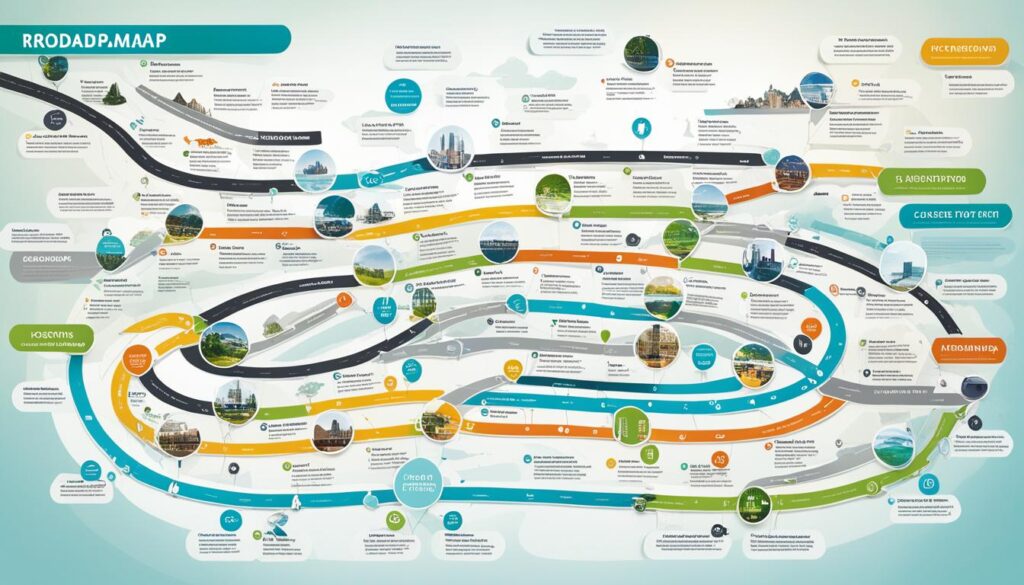Setting goals after high school is crucial for achieving career success. As a high school student, you are at a pivotal point in your life where your decisions can shape your future. Having long-term goals provides a sense of direction and purpose as you transition into the next phase of your life.
When you set goals, you give yourself something to strive for. It allows you to focus on what you want to achieve in your career and take the necessary steps to make it happen. Whether you dream of becoming a doctor, an engineer, a teacher, or an artist, having clear goals will help you stay focused and motivated.
So, what are these goals that you should consider after high school? This article will explore 19 goals that can pave the way to career success. From researching new career paths to gaining financial security and personal growth, these goals will inspire you to aim high and pursue the future you envision.
Key Takeaways:
- I am setting goals after high school is crucial for achieving career success.
- Long-term goals provide a sense of direction and purpose in your professional journey.
- Having clear goals helps you stay focused and motivated and take the necessary steps toward achieving your desired career success.
- Explore 19 goals that can pave the way to career success, from exploring new career paths to gaining financial security and personal growth.
What are Career Goals and Why are They Important?
Career goals are essential for professional development and are significant in your career journey. These goals are specific milestones you set for yourself, guiding you toward success. They serve as targets you aim to achieve, helping you advance in your chosen profession. By selecting career goals, you gain clarity on the skills and experiences you need to succeed in your field, and they provide a roadmap for your professional growth.
Setting career goals lets you focus on your long-term vision, breaking it into manageable steps and actionable objectives. It helps you maintain motivation and keep track of your progress, turning your aspirations into reality. Moreover, career goals allow you to challenge yourself, pushing beyond your comfort zone to reach new heights of personal and professional achievement.
With clear career goals, you can prioritize your efforts, making informed decisions about the opportunities you pursue and the investments you create in your professional development. Your goals provide direction and purpose, empowering you to navigate your career journey with intention and confidence.
“The future belongs to those who believe in the beauty of their dreams.” – Eleanor Roosevelt
By setting ambitious yet achievable career goals, you invest in your growth and create a roadmap for lifelong learning. You can identify the knowledge, skills, and experiences that will propel you forward and take deliberate steps toward acquiring them. Career goals act as a compass, ensuring you always move toward your desired destination.
Whether you aspire to climb the corporate ladder, start your own business, or make a meaningful impact in your chosen industry, career goals provide the framework for success. They give you a sense of purpose, challenge you to continuously improve, and inspire you to reach your full potential.
How to Choose Your Career Goals
When selecting your career goals, there is no one-size-fits-all approach. However, one effective method to consider is the REAL development goals approach. REAL stands for relevant, experimental, aspirational, and learning-based. Incorporating these elements into your goal-setting process ensures that your career goals are meaningful and aligned with your aspirations.
Relevant
First and foremost, it is crucial to choose career goals relevant to your interests, values, and aspirations. Reflect on what drives you and what you are passionate about. Consider your skills and talents and how they align with different career paths. By selecting goals that resonate with you, you will be more motivated to work towards achieving them.
Experimental
Exploring new opportunities and gaining varied experiences is integral to choosing your career goals. Take the time to engage in activities that provide insights into different industries, job roles, or areas of interest. This experimental approach allows you to assess what resonates with you and helps you make informed decisions about your future career.
Aspirational
While it is essential to set realistic goals, don’t be afraid to aim high and dream big. Consider what you aspire to achieve in your career and establish goals that push you out of your comfort zone. By setting aspirational goals, you challenge yourself to grow, develop new skills, and pursue opportunities that align with your long-term aspirations.
Learning-Based
Continuous learning is essential for career growth and development. Choose career goals that prioritize gaining new knowledge and skills. Identify areas where you can enhance your capabilities and seek opportunities to acquire relevant expertise. By focusing on learning, you expand your skill set, increase your value in the job market, and open doors to new career possibilities.
By using the REAL development goals approach, you can choose career goals that are truly meaningful and aligned with your aspirations. Remember to ensure relevance to your interests and values, experiment with different opportunities, set aspirational goals, and prioritize learning. This approach will lead you toward career success and personal fulfillment.

Examples of Career Goals
Setting career goals is essential for charting your professional path and achieving success. Here are some examples of career goals that can inspire your journey:
- Shift into a new career path: Explore your interests and passions to transition into a different field that aligns with your goals and values.
- Experience career stability: Seek job opportunities in industries with steady growth and demand to ensure long-term professional stability.
- Advance to a leadership position: Develop leadership skills and strive for promotions to take on managerial roles and significantly impact your organization.
- Work towards personal development: Set goals for acquiring new skills, improving interpersonal communication, and enhancing emotional intelligence.
- Earn certifications or degrees: Boost your knowledge and credentials by pursuing professional certifications or furthering your education with advanced degrees.
- Earn a promotion: Set your sights on climbing the corporate ladder by consistently delivering excellent performance and demonstrating leadership potential.
- Become an expert in your field: Focus on building expertise and gaining in-depth knowledge in your industry through continuous learning and staying updated with industry trends.
- Gain new skills: Identify areas for skill development and actively seek opportunities to learn and acquire new competencies.
- Publish a book: Share your expertise and insights with a broader audience by writing and publishing a book in your area of expertise.
- Increase performance metrics: Set specific performance targets, such as achieving sales targets, increasing customer satisfaction ratings, or improving productivity metrics.
“Setting career goals provides you with a roadmap to success. By defining your aspirations, you can proactively take steps to realize your dreams and shape your professional future.”
Everyone’s career journey is unique, and your goals should reflect your desires and ambitions. Use these examples as inspiration and tailor them to your specific circumstances. With well-defined career goals, you can pave the way for a fulfilling and successful professional life.

Next Steps:
Now that you have some examples of career goals, it’s time to start setting your own. In the next section, we will explore strategies for effectively setting goals that align with your aspirations and help you achieve long-term success.
Setting Short-Term Goals
Short-term goals are essential for progress and growth in various aspects of life. They are targets that you aim to achieve within a specific time frame, typically within a year or less. Setting short-term goals allows you to break down bigger aspirations into smaller, more manageable tasks. By focusing on short-term goals, you can maintain motivation, track your progress, and celebrate your accomplishments.
Types of Short-Term Goals
Short-term goals can be categorized into three main areas: academic, personal, and professional goals.
- Academic Goals: These goals are related to your education and skill development. Educational objectives include achieving specific grades, learning something new, completing a project, or participating in extracurricular activities that enhance your knowledge or expertise.
- Personal Goals: Personal goals focus on self-improvement, growth, and well-being. They can involve developing new skills, cultivating healthy habits, pursuing hobbies or interests, traveling, or planning adventures with friends and loved ones.
- Professional Goals: Professional goals pertain to your career and professional development. These goals may include gaining work experience through internships or part-time jobs, networking with industry professionals, obtaining relevant certifications or qualifications, or acquiring specific skills to advance your career.
Setting short-term goals in these areas allows you to create a well-rounded approach to personal and professional growth. It enables you to focus on various aspects of your life and work towards achieving success in different domains simultaneously.
“Setting short-term goals allows you to break down bigger aspirations into smaller, more manageable tasks.”
By setting short-term goals, you can effectively prioritize what is important to you at a given time and allocate your time and resources accordingly. Whether it’s improving your GPA, learning a new language, or gaining relevant work experience, short-term goals provide a framework for action and progress.
Remember, short-term goals are not set in stone and can be adjusted or modified as needed. Regularly evaluate your goals and make necessary changes to align them with your evolving priorities and circumstances.

Setting short-term goals is an integral part of personal and professional development. It helps you stay focused, motivated, and accountable. So, take the time to identify your short-term goals in academics, personal growth, and career advancement. Break them down into actionable steps and dedicate yourself to making steady progress towards achieving them. Remember, every small accomplishment brings you closer to your long-term vision of success.
Setting Long-Term Goals
Long-term goals, typically lasting beyond a year, are vital for individuals looking to achieve success over an extended period.
One common long-term goal is achieving financial security. By setting clear objectives and implementing effective financial strategies, you can work towards creating a stable and secure future for yourself and your loved ones.
Another important long-term goal is engaging in intercultural dialogue. Embracing diversity and actively seeking opportunities to connect with people from different backgrounds can foster understanding, empathy, and collaboration, promoting a harmonious and inclusive society.
Sacrificing comforts may be necessary for those pursuing an artistic career. Dedicated artists often need to make tough choices and forego certain luxuries to invest in their craft, enabling them to hone their skills and build a successful career in the arts.
Long-term goals may also include aspirations of becoming a recognized leader, starting a business, or furthering your education by pursuing a master’s or Ph.D. degree.
Setting long-term goals requires strategic planning and a clear vision of your goal. By establishing actionable steps and regularly assessing your progress, you can stay motivated and navigate your journey toward long-term success.
Example Table: Long-Term Goals
| Long-Term Goals | Description |
|---|---|
| Achieving Financial Security | We actively participate in conversations and activities promoting cross-cultural understanding and cooperation. |
| Engaging in Intercultural Dialogue | We are dedicating time, effort, and resources to pursue artistic passions and establish a successful career. |
| Sacrificing Comforts for an Artistic Career | You are acquiring the necessary skills, knowledge, and experiences to lead and make a positive impact within your chosen field. |
| Becoming a Recognized Leader | Acquiring the necessary skills, knowledge, and experiences to lead and make a positive impact within your chosen field. |

Strategies for Goal Setting
When setting goals, using the SMART goals framework is essential for success. SMART stands for Specific, Measurable, Attainable, Relevant, and Time-bound. By following this framework, you can ensure that your goals are well-defined and have a clear roadmap for achievement.
One strategy for practical goal setting is to write down your goals. This simple act can significantly increase your chances of success. When you write down your goals, you give them substance and make them tangible. It also allows you to revisit and review them regularly, keeping them top of mind.
Another strategy is to find an accountability partner. This can be a friend, colleague, or mentor who will hold you accountable for your goals. Having someone to share your progress, challenges, and setbacks with can provide valuable support and motivation.
Creating milestones is another critical strategy for goal setting. Milestones are specific achievements or checkpoints that mark your progress towards your goals. They help break down your goals into smaller, more manageable tasks, making them less overwhelming and more achievable.
To stay organized and focused, creating a daily to-do list is also beneficial. This list outlines the specific actions you must take daily to move closer to your goals. You can stay on track and maintain momentum by breaking down your goals into smaller, actionable steps.
“Setting a goal is not the main thing. It is deciding how you will go about achieving it and staying with that plan.” – Tom Landry
By incorporating these strategies into your goal-setting process, you can increase your chances of success and make progress toward your desired outcomes. Remember, setting SMART goals, writing them down, finding an accountability partner, creating milestones, and creating a daily to-do list are powerful tools for achieving your goals.

Comparison of Strategies for Goal Setting
| Strategies | Benefits |
|---|---|
| Using the SMART goals framework | – Helps in setting clear and well-defined goals – Ensures goals are measurable and time-bound – Provides a roadmap for goal achievement |
| Writing down goals | – Makes goals tangible and visible – Allows for regular review and reflection – Increases accountability and commitment |
| Finding an accountability partner | – Provides support and motivation – Holds you accountable for your goals – Allows for regular check-ins and progress sharing |
| Creating milestones | – Breaks down goals into smaller, achievable tasks – Tracks progress and provides a sense of accomplishment – Keeps you focused and motivated |
| Creating a daily to-do list | – Organizes tasks and priorities – Ensures consistent progress towards goals – Maintains focus and clarity |
Conclusion
Setting goals after high school is crucial for achieving career success. It gives individuals a sense of direction and purpose in their professional journey. Whether you are a high school student setting short-term goals for the academic year or planning long-term goals for the future, having goals helps you stay focused and motivated and take the necessary steps toward achieving your desired career success.
By setting goals after high school, you can turn your dreams into a reality. Whether you aspire to become a doctor, engineer, entrepreneur, or artist, clear goals allow you to chart your path and make informed decisions. They also help you prioritize your efforts, identify your needed skills and experiences, and stay motivated even during challenges.
Remember, goal setting is a continuous process. As you accomplish your goals, you can revise and set new ones to keep expanding your horizons and reaching greater heights. So, take the time to define your long-term vision, break it down into actionable steps, and stay committed to your journey. With perseverance and determination, you can transform your goals into tangible achievements and pave the way for a fulfilling and successful career.
FAQ
Why is setting goals after high school important for career success?
Setting goals after high school is crucial for achieving career success. It provides individuals with a sense of direction and purpose in their professional journey, allowing them to focus on what they want to achieve in their careers and take the necessary steps to make it happen.
What are career goals and why are they important?
Career goals are specific milestones that individuals set for themselves to aid in their professional development. They are the targets that individuals aim to achieve to advance in their career journey. Career goals help individuals identify the skills and experiences they need to succeed in their chosen profession and provide a roadmap for reaching their goals in a timely and calculated manner.
How can I choose my career goals?
One effective approach to choosing career goals is using the REAL development goals approach. This acronym stands for relevant, experimental, aspirational, and learning-based. When choosing career goals, it is important to consider why they are important and worthwhile (relevant), engage in development activities that provide greater insight (experimental), identify desired areas of development (aspirational), and focus on gaining capability and knowledge (learning-based).
What are some examples of career goals?
Examples of career goals include shifting into a new career path, experiencing career stability, advancing to a leadership position, working towards personal development, earning certifications or degrees, earning a promotion, becoming an expert in their field, gaining new skills, publishing a book, and increasing performance metrics.
What are short-term goals?
Short-term goals are goals that individuals aim to achieve within a specific time frame, typically within a year or less. These goals can be categorized into academic goals (achieving specific grades, learning something new, participating in extracurricular activities), personal goals (developing new skills, traveling, planning adventures with friends), and professional goals (gaining work experience, networking, obtaining certifications).
What are long-term goals?
Long-term goals are goals that individuals strive to achieve over a longer period of time, typically beyond a year. These goals may include achieving financial security, engaging in intercultural dialogue, sacrificing comforts for an artistic career, becoming a recognized leader, starting a business, or pursuing further education like a master’s or Ph.D. degree. Long-term goals require strategic planning and may involve personal passion and vision.
What are some strategies for goal setting?
Strategies for goal setting include using the SMART goals framework (specific, measurable, attainable, relevant, and time-bound), writing down goals, finding an accountability partner, creating milestones to track progress, and creating a daily to-do list. These strategies help individuals stay focused, motivated, and organized in working towards their goals.





